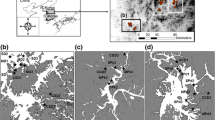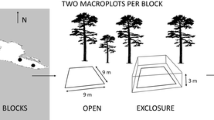Abstract
Patch size is known to affect biodiversity in fragmented landscapes, but is usually examined in systems where the surrounding matrix habitat is unfavourable. We examined beetle diversity in a floodplain ecosystem that is characterised by naturally occurring grassland patches within a dominant matrix of contrasting yet habitable forest. We asked whether differences in the beetle assemblage between grassland and forest vegetation depended on the area of the grassland patch, which is a function of its flooding frequency and duration: smaller grasslands tend to be higher on the floodplain and are flooded less often and for shorter periods than larger grasslands. We found a negative relationship between grassland area and beetle abundance and species richness, and a positive relationship between grassland area and compositional dissimilarity from the surrounding forest. As expected, we found an overall difference in composition between forest and grassland assemblages, with five beetle species more common in the grasslands. Our study indicates that floodplain grasslands not only support beetle assemblages that are distinct from the surrounding forest, but that assemblages from the larger grasslands are compositionally more distinct than those from smaller grasslands. A likely cause of this pattern is the reduced edge effects and greater environmental contrast between forest and large grasslands that may be exposed to greater variation in local climate. Ongoing changes to flood regimes and potential encroachment of forest plants may decrease grassland area in the future, which may reduce spatial heterogeneity in the insect community in this unique floodplain ecosystem.





Similar content being viewed by others
References
Andersen AN, Fisher A, Hoffmann BD, Read JL, Richards R (2004) Use of terrestrial invertebrates for biodiversity monitoring in Australian rangelands, with particular reference to ants. Aust Ecol 29:87–92
Anderson MJ (2001) A new method for non-parametric multivariate analysis of variance. Aust Ecol 26:32–46
Ballinger A, Mac Nally R (2006) The landscape context of flooding in the Murray–Darling basin. Adv Ecol Res 39:85–105
Ballinger A, Mac Nally R, Lake PS (2005) Immediate and longer-term effects of managed flooding on floodplain invertebrate assemblages in south–eastern Australia: generation and maintenance of a mosaic landscape. Freshw Biol 50:1190–1205
Ballinger A, Lake PS, Mac Nally R (2007) Do terrestrial invertebrates experience floodplains as landscape mosaics? Immediate and longer-term effects of flooding on ant assemblages in a floodplain forest. Oecologia 152:227–238
Barton PS, Manning AD, Gibb H, Lindenmayer DB, Cunningham SA (2009) Conserving ground-dwelling beetles in an endangered woodland community: multi-scale habitat effects on assemblage diversity. Biol Conserv 142:1701–1709
Basset Y et al (2012) Arthropod diversity in a tropical forest. Science 338:1481–1484
Bren L (1992) Tree invasion of an intermittent wetland in relation to changes in flooding frequency of the River Murray, Australia. Aust J Ecol 17:395–408
Bren L (2005) The changing hydrology of the Barmah–Millewa Forests and its effects on vegetation. Proc R Soc Vic 117:61–76
Bren LJ, O’Neill IC, Gibbs NL (1988) Use of map analysis to elucidate flooding in an Australian riparian river red gum forest. Water Resour Res 24:1152–1162
Campbell RE, Harding JS, Ewers RM, Thorpe S, Didham RK (2011) Production land use alters edge response functions in remnant forest invertebrate communities. Ecol Appl 21:3147–3161
Casanova MT, Brock MA (2000) How do depth, duration and frequency of flooding influence the establishment of wetland plant communities? Plant Ecol 147:237–250
Catford JA, Downes BJ, Gippel CJ, Vesk PA (2011) Flow regulation reduces native plant cover and facilitates exotic invasion in riparian wetlands. J Appl Ecol 48:432–442
Chesterfield EA (1986) Changes in the vegetation of the river red gum forest at Barmah, Victoria. Aust For 49:4–15
Colloff MJ, Baldwin DS (2010) Resilience of floodplain ecosystems in a semi–arid environment. Rangel J 32:305–314
Colloff MJ, Ward KA, Roberts J (2013) Ecology and conservation of floodplain grassy wetlands in the southern Murray–Darling Basin, Australia. Aquatic conservation: marine and freshwater ecosystems. doi:10.1002/aqc.2390
Colwell RK (2013) EstimateS 9: Statistical estimation of species richness and shared species from samples. (http://purl.oclc.org/estimates)
Colwell RK, Mao CX, Chang J (2004) Interpolating, extrapolating, and comparing incidence-based species accumulation curves. Ecology 85:2717–2727
CSIRO (2008) Water availability in the Murray–Darling Basin. A report to the Australian Government from the CSIRO Murray–Darling Basin Sustainable Yields Project. CSIRO, Canberra. www.csiro.au/partnerships/MDBSY
Cunningham SC et al (2009) A robust technique for mapping vegetation across a major river system. Ecosystems 12:207–219
Dangerfield JM et al (2003) Patterns of invertebrate biodiversity across a natural edge. Aust Ecol 28:227–236
Dexter BD, Rose HJ, Davies N (1986) River regulation and associated forest management problems in the River Murray red gum forests. Aust For 49:16–27
Didham RK, Ghazoul J, Stork NE, Davis AJ (1996) Insects in fragmented forests: a functional approach. Trends Ecol Evol 11:255–260
Didham RK, Hammond PM, Lawton JH, Eggleton P, Stork NE (1998) Beetle species responses to tropical forest fragmentation. Ecol Monogr 68:295–323
D’Odorico P, He Y, Collins S, De Wekker SFJ, Engel V, Fuentes JD (2012) Vegetation–microclimate feedbacks in woodland–grassland ecotones. Glob Ecol Biogeogr. doi:10.1111/geb.12000:onlineearly
Driscoll DA, Banks SC, Barton PS, Lindenmayer DB, Smith AL (2013) The conceptual domain of the matrix in fragmented landscapes. Trends Ecol Evol. doi:10.1016/j.tree.2013.1006.1010
DSE (2008) Barmah forest ramsar site ecological character description. Victorian Government Department of Sustainability and Environment, Melbourne. http://www.dse.vic.gov.au/__data/assets/pdf_file/0010/100108/Barmah_Forest_Ramsar_Site_ecological_character_description.pdf
Dufrene M, Legendre P (1997) Species assemblages and indicator species: the need for a flexible asymmetrical approach. Ecol Monogr 67:345–366
Environment Australia (2001) A directory of important wetlands in Australia, 3rd edn. Environment Australia, Canberra
Ewers RM, Didham RK (2006) Confounding factors in the detection of species responses to habitat fragmentation. Biol Rev 81:117–142
Gerisch M, Agostinelli V, Henle K, Dziock F (2012) More species, but all do the same: contrasting effects of flood disturbance on ground beetle functional and species diversity. Oikos 121:508–515
Gotelli NJ, Colwell RK (2001) Quantifying biodiversity: procedures and pitfalls in the measurement and comparison of species richness. Ecol Lett 4:379–391
Haila Y (2002) A conceptual genealogy of fragmentation research: from island biogeography to landscape ecology. Ecol Appl 12:321–334
Hunt T et al (2007) A comprehensive phylogeny of beetles reveals the evolutionary origins of a superradiation. Science 318:1913–1916
King AJ, Ward KA, O’Connor P, Green D, Tonkin Z, Mahoney J (2010) Adaptive management of an environmental watering event to enhance native fish spawning and recruitment. Freshw Biol 55:17–31
Lawrence JF, Britton EB (1994) Australian beetles. Melbourne University Press, Melbourne
Lawrence JF, Hastings AM, Dallwitz MJ, Paine TA, Zurcher EJ (1999) ‘Beetles of the world: a key and information system for families and subfamilies. CSIRO Publishing, Melbourne
Lessel T, Marx MT, Eisenbeis G (2011) Effects of ecological flooding on the temporal and spatial dynamics of carabid beetles (Coleoptera, Carabidae) and springtails (Collembola) in a polder habitat. Zookeys 100:421–446
Lindsay EA, Cunningham SA (2009) Livestock grazing exclusion and microhabitat variation affect invertebrates and litter decomposition rates in woodland remnants. For Ecol Manage 258:178–187
Losey JE, Vaughan M (2006) The economic value of ecological services provided by insects. Bioscience 56:311–323
Mac Nally R, Cunningham SC, Baker PJ, Horner GJ, Thomson JR (2011) Dynamics of Murray–Darling floodplain forests under multiple stressors: The past, present, and future of an Australian icon. Water Resour Res 47:0005
Mayence CE, Marshall DJ, Godfree RC (2010) Hydrologic and mechanical control for an invasive wetland plant, Juncus ingens, and implications for rehabilitating and managing Murray River floodplain wetlands, Australia. Wetl Ecol Manag 18:717–730
Mazia CN, Chaneton EJ, Kitzberger T (2006) Small-scale habitat use and assemblage structure of ground-dwelling beetles in a Patagonian shrub steppe. J Arid Environ 67:177–194
McCune B, Grace JB (2002) Analysis of ecological communities. MjM Software Design, Gleneden Beach
McCune B, Mefford MJ (2006) PC–ORD. Multivariate analysis of ecological data. version 5.1. MjM Software, Gleneden Beach
Melbourne BA (1999) Bias in the effect of habitat structure on pitfall traps: an experimental evaluation. Aust J Ecol 24:228–239
Murray Darling Basin Authority (2012) Barmah–Millewa forest environmental water management plan. MDBA Publication No. 219/11. Murray–Darling Basin Authority, Canberra
Öckinger E et al (2012) The landscape matrix modifies the effect of habitat fragmentation in grassland butterflies. Landsc Ecol 27:121–131
Oliver I, Beattie AJ (1996) Invertebrate morphospecies as surrogates for species: a case study. Conserv Biol 10:99–109
Peyras M, Vespa NI, Bellocq MI, Zurita GA (2013) Quantifying edge effects: the role of habitat contrast and species specialization. J Insect Conserv 17:807–820
Pik AJ, Dangerfield JM, Bramble RA, Angus C, Nipperess DA (2002) The use of invertebrates to detect small–scale habitat heterogeneity and its application to restoration practices. Environ Monit Assess 75:179–199
Potter NJ, Chiew FHS (2011) An investigation into changes in climate characteristics causing the recent very low runoff in the southern Murray–Darling Basin using rainfall–runoff models. Water Resour Res 47:W00G10
Reid MA, Quinn GP (2004) Hydrologic regime and macrophyte assemblages in temporary floodplain wetlands: implications for detecting responses to environmental water allocations. Wetlands 24:586–599
Ries L, Fletcher RJ, Battin J, Sisk TD (2004) Ecological responses to habitat edges: mechanisms, models, and variability explained. Annu Rev Ecol Evol Syst 35:491–522
Rothenbucher J, Schaefer M (2006) Submersion tolerance in floodplain arthropod communities. Basic Appl Ecol 7:398–408
Samways MJ, McGeoch MA, New TR (2010) Insect conservation: a handbook of approaches and methods. Oxford University Press Inc., New York
Shmida A, Wilson MV (1985) Biological determinants of species diversity. J Biogeogr 12:1–20
Sims NC, Chariton A, Jin H, Colloff MJ (2012) A classification of floodplain ecosystems in the Murray–Darling Basin based on changes in flooding between pre-regulation and current conditions. Wetlands 32:239–248
Sokal RR, Rohlf FJ (1995) Biometry: the principles and practice of statistics in biological research, 13th edn. W. H. Freeman and Co., New York
Stokes KE, Cunningham SA (2006) Predictors of recruitment for willows invading riparian environments in south-east Australia: implications for weed management. J Appl Ecol 43:909–921
Stokes KE, Ward K, Colloff MJ (2010) Alterations in flood frequency increase exotic and native species richness of understorey vegetation in a temperate floodplain eucalypt forest. Plant Ecol 211:219–233
Tscharntke T et al (2012) Landscape moderation of biodiversity patterns and processes—eight hypotheses. Biol Rev 87:661–685
Vasconcelos HL, Vilhena JMS, Facure KG, Albernaz A (2010) Patterns of ant species diversity and turnover across 2,000 km of Amazonian floodplain forest. J Biogeogr 37:432–440
Vivian L, Godfree R (2012) The response of a degraded Murray River floodplain wetland to extreme drought and flood. In: Grove JR, Rutherford I (eds) Proceedings of the 6th Australian stream management conference: managing for extremes. River Basin Management Authority, Canberra, pp 1–7
VSNI (2013) GenStat for Windows, 14th edn. VSNI Ltd., Hemel Hempstead
Ward K, Colloff M (2010) Ecosystem response modelling for the Barmah–Millewa Forest: the interface between science and management. In: Saintilan N, Overton I (eds) Ecosystem Response Modelling in the Murray–Darling Basin. CSIRO Publishing, Collingwood, pp 345–356
Acknowledgments
We are grateful to Raphael Didham and John Evans for providing thoughtful comments on an early version of the manuscript. We also thank Rolf Oberprieler, Adam Slipinski, Tom Weir and Hermes Escalona Garcia at the Australian National Insect Collection, CSIRO Ecosystem Sciences, for confirming the identity of some beetle species. We thank our research partners, Keith Ward and Neville Atkinson, Goulburn-Broken Catchment Management Authority; Paul O’Connor, Department of Sustainability and Environment; Lee Joachim, Yorta Yorta Nation Aboriginal Corporation; and Kane Weekes, Parks Victoria. Fieldwork was conducted under permit from Department of Sustainability and Environment and Parks Victoria. This research was funded by CSIRO Water for a Healthy Country National Research Flagship.
Author information
Authors and Affiliations
Corresponding author
Electronic supplementary material
Below is the link to the electronic supplementary material.
Rights and permissions
About this article
Cite this article
Barton, P.S., Colloff, M.J., Pullen, K.R. et al. Grassland area determines beetle assemblage dissimilarity from surrounding floodplain forest. J Insect Conserv 17, 1209–1219 (2013). https://doi.org/10.1007/s10841-013-9602-8
Received:
Accepted:
Published:
Issue Date:
DOI: https://doi.org/10.1007/s10841-013-9602-8




